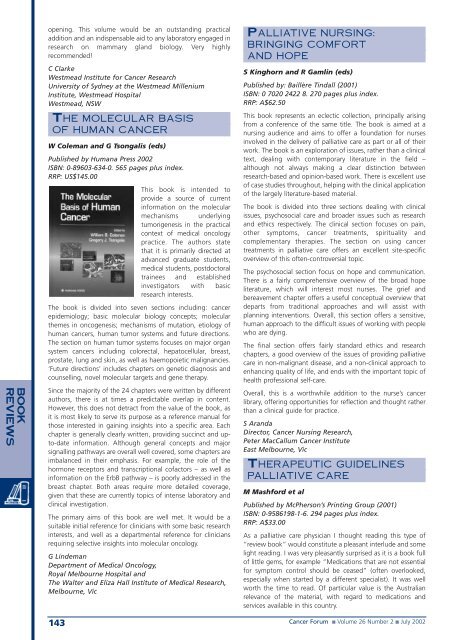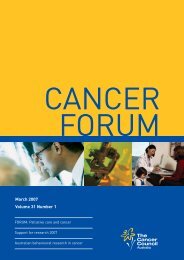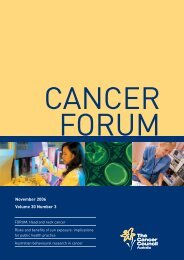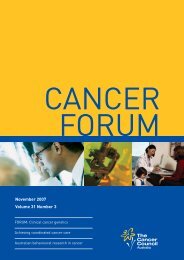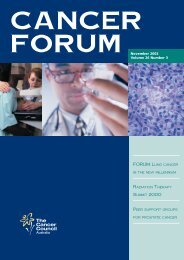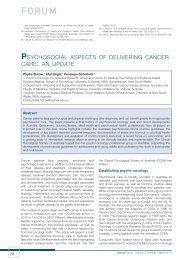Cancer Forum
Cancer Forum
Cancer Forum
- No tags were found...
You also want an ePaper? Increase the reach of your titles
YUMPU automatically turns print PDFs into web optimized ePapers that Google loves.
ookreviewsopening. This volume would be an outstanding practicaladdition and an indispensable aid to any laboratory engaged inresearch on mammary gland biology. Very highlyrecommended!C ClarkeWestmead Institute for <strong>Cancer</strong> ResearchUniversity of Sydney at the Westmead MilleniumInstitute, Westmead HospitalWestmead, NSWTHE MOLECULAR BASISOF HUMAN CANCERW Coleman and G Tsongalis (eds)Published by Humana Press 2002ISBN: 0-89603-634-0. 565 pages plus index.RRP: US$145.00This book is intended toprovide a source of currentinformation on the molecularmechanisms underlyingtumorigenesis in the practicalcontext of medical oncologypractice. The authors statethat it is primarily directed atadvanced graduate students,medical students, postdoctoraltrainees and establishedinvestigators with basicresearch interests.The book is divided into seven sections including: cancerepidemiology; basic molecular biology concepts; molecularthemes in oncogenesis; mechanisms of mutation, etiology ofhuman cancers, human tumor systems and future directions.The section on human tumor systems focuses on major organsystem cancers including colorectal, hepatocellular, breast,prostate, lung and skin, as well as haemopoietic malignancies.‘Future directions’ includes chapters on genetic diagnosis andcounselling, novel molecular targets and gene therapy.Since the majority of the 24 chapters were written by differentauthors, there is at times a predictable overlap in content.However, this does not detract from the value of the book, asit is most likely to serve its purpose as a reference manual forthose interested in gaining insights into a specific area. Eachchapter is generally clearly written, providing succinct and upto-dateinformation. Although general concepts and majorsignalling pathways are overall well covered, some chapters areimbalanced in their emphasis. For example, the role of thehormone receptors and transcriptional cofactors – as well asinformation on the ErbB pathway – is poorly addressed in thebreast chapter. Both areas require more detailed coverage,given that these are currently topics of intense laboratory andclinical investigation.The primary aims of this book are well met. It would be asuitable initial reference for clinicians with some basic researchinterests, and well as a departmental reference for cliniciansrequiring selective insights into molecular oncology.G LindemanDepartment of Medical Oncology,Royal Melbourne Hospital andThe Walter and Eliza Hall Institute of Medical Research,Melbourne, Vic143PALLIATIVE NURSING:BRINGING COMFORTAND HOPES Kinghorn and R Gamlin (eds)Published by: Baillère Tindall (2001)ISBN: 0 7020 2422 8. 270 pages plus index.RRP: A$62.50This book represents an eclectic collection, principally arisingfrom a conference of the same title. The book is aimed at anursing audience and aims to offer a foundation for nursesinvolved in the delivery of palliative care as part or all of theirwork. The book is an exploration of issues, rather than a clinicaltext, dealing with contemporary literature in the field –although not always making a clear distinction betweenresearch-based and opinion-based work. There is excellent useof case studies throughout, helping with the clinical applicationof the largely literature-based material.The book is divided into three sections dealing with clinicalissues, psychosocial care and broader issues such as researchand ethics respectively. The clinical section focuses on pain,other symptoms, cancer treatments, spirituality andcomplementary therapies. The section on using cancertreatments in palliative care offers an excellent site-specificoverview of this often-controversial topic.The psychosocial section focus on hope and communication.There is a fairly comprehensive overview of the broad hopeliterature, which will interest most nurses. The grief andbereavement chapter offers a useful conceptual overview thatdeparts from traditional approaches and will assist withplanning interventions. Overall, this section offers a sensitive,human approach to the difficult issues of working with peoplewho are dying.The final section offers fairly standard ethics and researchchapters, a good overview of the issues of providing palliativecare in non-malignant disease, and a non-clinical approach toenhancing quality of life, and ends with the important topic ofhealth professional self-care.Overall, this is a worthwhile addition to the nurse’s cancerlibrary, offering opportunities for reflection and thought ratherthan a clinical guide for practice.S ArandaDirector, <strong>Cancer</strong> Nursing Research,Peter MacCallum <strong>Cancer</strong> InstituteEast Melbourne, VicTHERAPEUTIC GUIDELINESPALLIATIVE CAREM Mashford et alPublished by McPherson’s Printing Group (2001)ISBN: 0-9586198-1-6. 294 pages plus index.RRP: A$33.00As a palliative care physician I thought reading this type of“review book” would constitute a pleasant interlude and somelight reading. I was very pleasantly surprised as it is a book fullof little gems, for example “Medications that are not essentialfor symptom control should be ceased” (often overlooked,especially when started by a different specialist). It was wellworth the time to read. Of particular value is the Australianrelevance of the material, with regard to medications andservices available in this country.<strong>Cancer</strong> <strong>Forum</strong> ■ Volume 26 Number 2 ■ July 2002


